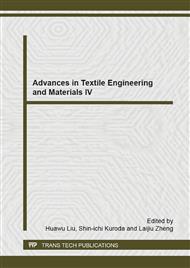[1]
A. Yu, K. L. Yick, S. P. Ng, J. Yip, Prediction of fabric tension and pressure decay for the development of pressure therapy gloves. Textile Research Journal, 2013. 83(3): pp.269-287.
DOI: 10.1177/0040517512456757
Google Scholar
[2]
D. D. Culic, M. C. Battaglia, C. B. S. Wichman, F. R. Schmid, Efficacy of compression gloves in rheumatoid-arthritis. American Journal of Physical Medicine & Rehabilitation, 1979. 58(6): pp.278-284.
Google Scholar
[3]
P.T. McKnight, C.K. Kwoh, Randomized, controlled trial of compression gloves in rheumatoid arthritis. Arthritis Care and Research, 1992. 5(4): pp.223-227.
DOI: 10.1002/art.1790050407
Google Scholar
[4]
K.A. O'Brien, G. Weinstock-Zlotnick, J. Sanchez, D. Gorga, R. Y. W. Yurt, Comparison of Positive Pressure Gloves on Hand Use in Uninjured Persons. Journal of Burn Care & Research, 2005. 26(4): pp.363-368.
DOI: 10.1097/01.bcr.0000169888.47327.00
Google Scholar
[5]
G. Weinstock-Zlotnick, D. Torres-Gray, R. Segal, Effect of pressure garment work gloves on hand function in patients with hand burns: a pilot study. Journal of Hand Therapy, 2004. 17(3): pp.368-376.
DOI: 10.1197/j.jht.2004.04.007
Google Scholar
[6]
A. Askari, R.W. Moskowitz, C. Ryan, Stretch gloves: a study of objective and subjective effectiveness in arthritis of the hands. Arthritis and Rheumatism, 1974. 17(3): pp.263-265.
DOI: 10.1002/art.1780170310
Google Scholar
[7]
G.E. Ehrlich, A.M. DiPiero, Stretch gloves: nocturnal use to ameliorate morning stiffness in arthritic hands. Archives of Physical Medicine and Rehabilitation, 1971. 52(10): pp.479-80.
Google Scholar
[8]
S.C. Anand, K.K. Govarthanam, D. Gazioglu, A study of the modelling and characterisation of compression garments for hypertrophic scarring after burns. Part 1: modelling of compression garments. Journal of The Textile Institute, 2013. 104(7): pp.661-667.
DOI: 10.1080/00405000.2012.753697
Google Scholar
[9]
L. Macintyre, Designing pressure garments capable of exerting specific pressures on limbs. Burns, 2007. 33(5): pp.579-586.
DOI: 10.1016/j.burns.2006.10.004
Google Scholar
[10]
O. Troynikov, E. Ashayeri, F.K. Fuss, Tribological evaluation of sportswear with negative fit worn next to skin. Proceedings of the Institution of Mechanical Engineers, Part J: Journal of Engineering Tribology, 2011. 226(7).
DOI: 10.1177/1350650111425876
Google Scholar
[11]
O. Troynikov, E, Ashayeri, M. Burton, A. Subic, F. Alam, S. Marteau, Factors influencing the effectiveness of compression garments used in sports. Procedia Engineering, 2010. 2(2): pp.2823-2829.
DOI: 10.1016/j.proeng.2010.04.073
Google Scholar
[12]
Sau-Fun, N., H. Chi-Leung, and W. Lai-Fan, Development of medical garments and apparel for the elderly and the disabled. Textile Progress, 2011. 43(4): pp.235-285.
DOI: 10.1080/00405167.2011.573240
Google Scholar
[13]
F. Yip, S-F. N, Medical clothing: The stress relaxation and shrinkage of pressure garments. International Journal of Clothing Science and Technology, 1994. 6(4): p.17.
DOI: 10.1108/09556229410063468
Google Scholar
[14]
N. Yıldız, A novel technique to determine pressure in pressure garments for hypertrophic burn scars and comfort properties. Burns, 2007. 33(1): pp.59-64.
DOI: 10.1016/j.burns.2006.04.026
Google Scholar
[15]
Australian standard, Method of test for textiles; Method 2. 6 physical test; Determination of the number of wales and courses per unit length of knitted fabric. (2001).
Google Scholar
[16]
Australian standard, Method of test for textiles; Method 2. 15 physical test; Determination of thickness of textile fabrics. (1989).
Google Scholar
[17]
Australian standard, Method of test for textiles; Physical test; Determination of mass per unit area and mass per unit length of fabrics. (1987).
DOI: 10.3403/01411761u
Google Scholar
[18]
Australian standard, Method of test for textiles; Conditioning procedures. (1995).
Google Scholar


